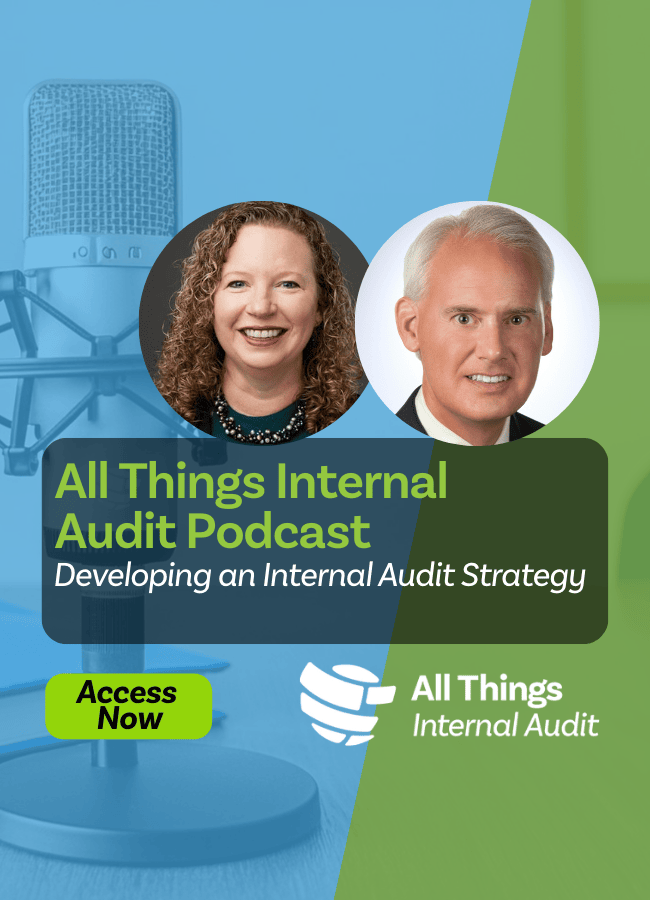00:00:03 Speaker 1
Hello, welcome to getting started with where our job is to make your job easier.
00:00:09 Speaker 1
On this episode, we're getting started with critical thinking, something that might sound simple but is essential. You'll learn what critical thinking really means in the context of internal audit, how it improves your audit work, and practical tips to build your critical thinking muscle. So let's get started.
00:00:26 Speaker 1
Critical thinking is the ability to objectively analyze information, ask the right questions, and arrive at well reasoned conclusions in auditing, it means resisting assumptions, digging beneath the surface, and staying curious. Think of it like this great auditors are part Detective, part analyst. When something looks off, critical thinking is what helps you separate coincidence.
00:00:48 Speaker 1
From causality. So why does it matter? Critical thinking supports objectivity. One of our core attributes as internal auditors and our first term to learn.
00:00:57 Speaker 1
Objectivity is an unbiased mental attitude that allows internal auditors and make professional judgements, fulfill their responsibilities and achieve the purpose of internal auditing without compromise. It helps you assess evidence fairly strength and recommendations, spot red flags and avoid jumping to conclusions.
00:01:14 Speaker 1
From planning to reporting, you'll use critical thinking in every phase. Let's walk through some examples. In the planning phase, ask yourself, why is this area on the audit plan? What risks are we really trying to understand? What controls are in place to mitigate risks?
00:01:30 Speaker 1
During field work, critical thinking helps you evaluate the quality of your evidence. Ask does this data really support the conclusion I'm drawing? Could the results be biased or influenced by management? What could go wrong in this area that we?
00:01:42 Speaker 1
Have not.
00:01:42 Speaker 1
Considered when you reach the reporting phase right with reason, critical thinking guides how you write and communicate your findings.
00:01:51 Speaker 1
So write thoughtfully, logically and with clear purpose, ensuring every word, sentence, and conclusion is supported by evidence and sound analysis. Here's how to write with reason during.
00:02:01 Speaker 1
The reporting phase.
00:02:03 Speaker 1
One base every statement on evidence, avoid assumptions or vague claims. Try to use exact numbers or percentages and not use vague terms like many or few. Use data, observations and audit findings to back up your conclusions.
00:02:19 Speaker 1
Two stay objective and unemotional. Let facts speak louder than frustration or personal opinions. Avoid exaggeration or emotionally charged language.
00:02:29 Speaker 1
Three, be clear and concise. Eliminate fluff, write to inform, not to impress. Get to the point quickly and use plain language. Your audience will understand.
00:02:40 Speaker 1
4 organized logically you structure to guide the reader, identify the issue, define the criteria, determine the cause and effect, then issue your recommendation, prioritize significant findings and group related topics.
00:02:54 Speaker 1
5 use critical thinking. Consider multiple viewpoints before making recommendations. Identify root causes, not just surface level symptoms.
00:03:03 Speaker 1
For example, instead of, the team often overlooks documentation right in four of the five samples. Review documentation of approvals with incomplete or missing.
00:03:13 Speaker 1
One useful tool that pairs perfectly with critical thinking is root cause analysis. It's a methodology that trains your brain to look for why something happened, not just what happened. It's designed to help you go beyond symptoms and identify underlying issues.
00:03:28 Speaker 1
Here's a bright idea. Make critical thinking a daily habit. Schedule a few minutes at the end of your audit.
00:03:34 Speaker 1
Day to reflect.
00:03:35 Speaker 1
Critical thinking is more than just analyzing data. It's question and assumptions, making sound judgments and solving problems with clarity and logic.
00:03:44 Speaker 1
Here's how to strengthen this essential internal audit skill.
00:03:47 Speaker 1
One ask better questions. Challenge surface level answers by asking why, how, and what.
00:03:54 Speaker 1
If.
00:03:54 Speaker 1
Dig into causes, consequences and context instead of just symptoms. For example, instead of why did this control fail? Ask what systemic issues allowed this control to fail?
00:04:06 Speaker 1
Repeatedly.
00:04:07 Speaker 1
Two practice active listening. Focus fully on what stakeholders are saying and not.
00:04:13 Speaker 1
Saying.
00:04:14 Speaker 1
Listen for inconsistencies, assumptions or vague responses.
00:04:18 Speaker 1
3 evaluate evidence objectively.
00:04:21 Speaker 1
Separate facts from opinions or anecdotes. Look for patterns across multiple data points before drawing conclusions.
00:04:29 Speaker 1
Avoid jumping to conclusions after reviewing just one source.
00:04:32 Speaker 1
4.
00:04:33 Speaker 1
Consider multiple perspectives. Play devil's advocate. What might someone else argue?
00:04:40 Speaker 1
Look at the issue through the lens of management. The board or customers.
00:04:44 Speaker 1
Why does this matter? Because broad perspectives uncover blind spots and lead to more balanced recommendations.
00:04:51 Speaker 2
5 pause.
00:04:52 Speaker 1
Reflect before reacting. Take time to think through your conclusion. Are there gaps in your reasoning? Write it out and challenge your own assumptions. 6 Make critical thinking a habit debrief after projects. What worked, what didn't and why?
00:05:10 Speaker 1
Here's a pro tip. Bounce ideas off your teammates? Collaborative brainstorming is a great way to uncover blind spots.
00:05:19 Speaker 1
Remember, internal auditors don't just check boxes. We help organizations see around corners. Critical thinking is what sharpens that forward-looking view. So remember these steps.
00:05:30 Speaker 1
1.
00:05:31 Speaker 1
Spot the bigger picture, look beyond isolated issues to identify emerging trends and patterns. Ask how today's control failure could signal tomorrow's risk. For example, delay in approvals today might hint at deeper process and efficiencies or under staffing that could impact compliance.
00:05:47 Speaker 1
Line 2 challenge the status quo. Use critical thinking to question outdated processes or assumptions. Don't accept we've always done it this way. Ask if it's still effective. Evaluate risks in light of current business priorities, not just historical ones.
00:06:02 Speaker 1
Three, connect the dots. Link individual findings to broader organizational risks or objectives. Think in systems how does one weak link affect the chain? This mindset helps leadership make more informed decisions based on real risk exposure. 4 anticipate consequences. Don't just report what went wrong, consider what could happen if nothing.
00:06:02 Speaker 2
Sorry.
00:06:23 Speaker 1
Changes use if then thinking to show the ripple effects of an action.
00:06:27 Speaker 1
5 support strategic decision making. Translate audit findings into business insights help leaders understand not just what's wrong, but also what's at stake.
00:06:38 Speaker 1
Thanks for watching. Getting started with critical thinking. Next, be sure to watch our episode on planning and route calls analysis. There's so much more to learn.
00:06:47 Speaker 1
You can find these episodes and other helpful resources, including tools, podcasts, and training at the links below.


